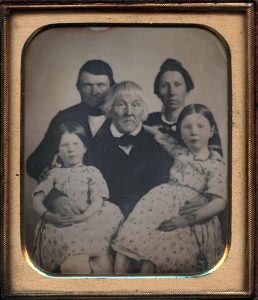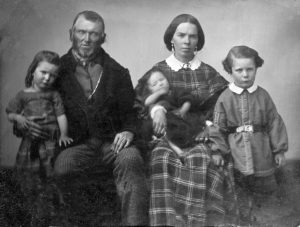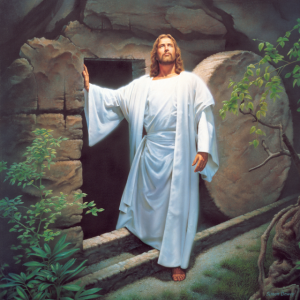by Jennifer Ann Mackley
Willing to Sacrifice
On August 7, 1839, a very ill Wilford Woodruff prepared to leave his pregnant wife, Phebe, and his one-year-old daughter, Sarah Emma, to serve a mission with other members of the Quorum of the Twelve in the British Isles. He wrote, “I make a sacrifice of my all for Christ’s sake to do his work. It is no small trial of faith.”
In November 1839, he was still recovering from his illness and preaching the gospel in New York while awaiting the departure of their ship to England. Over the course of three weeks, he recorded three dreams about his wife and child. On November 8, he wrote, “I saw Mrs. Woodruff in deep affliction in a dream at Montrose. I did not see Sarah Emma.” Three days later he noted, “I had a dream during the night and had an interview with Mrs. Woodruff, but did not see Sarah Emma.”
On November 28 he recorded the third dream, “I saw Mrs. Woodruff & notwithstanding we rejoiced much at having an interview with each other, yet our embraces were mixed with sorrow, for after conversing a while about her domestic affairs, I asked where Sarah Emma was (our only child). She says weeping, and kissing me, she is dead. … Is this dream true? Time must determine.”
Eight months later, July 14, 1840, Wilford Woodruff, recorded the occasion of Sarah Emma’s second birthday in his journal and added, “May the Lord preserve my wife and children from sickness and death until my return.” He then added, “O Lord, I commit them into thy hands; feed, clothe, and comfort them, and thine shall be the glory.”
Sarah Emma died on July 17, 1840 and a grief stricken Phebe wrote a letter to her husband the following day expressing her feelings: “Yesterday I was called to witness the departure of our little Sarah Emma from this world — yes she is gone — the relentless hand of death has snatched her from my embrace.” Phebe did not think she could bear losing her sweet child while also enduring Wilford’s absence, but shared her faith that “the Lord has taken her to himself for some wise purpose.” She then added “the Lord has stood by me in a wonderful manner.”
Her knowledge of the resurrection and eternal life sustained her, “I can see and feel that he has taken her home and will take better care of her than I possibly could for a little while until I shall go and meet her — Yes Willford we have one little angel in heaven.”
Wilford Woodruff did not receive Phebe’s letter for three months. It was accompanied by a poem written by Margaret Smoot. The closing stanza read:
“Yes, little Sarah, lovely one, sleep on sleep on, ‘till Christ shall come.
Then thou wilt rise shake off thy dust, And be numbered with the just.”
The Gospel Brings Life and Light
In addition to Sarah Emma, four of Wilford and Phebe Woodruff’s nine children died as infants, two sons within a month of each other in Winter Quarters. The heartbreak they faced, the loss they endured could have shattered their faith in a loving God. Instead they put their faith in God’s revealed truths. Wilford taught, “The resurrection of the dead presents itself before the enlightened mind of man, and he has a foundation for his spirit to rest upon. That is the position of the Latter-day Saints today. We do know for ourselves, we are not in the dark with regard to this matter; God has revealed it to us and we do understand the principle of the resurrection of the dead, and that the gospel brings life and immortality to light.”[1]

Records of Divine Truth
After the loss of thirteen of his own children, and so many other children of the early pioneers, Wilford reminded them that, “Children are innocent before the Lord; as to their death and the cause thereof, that is in the hands of God, and we should not complain of the Lord or his dispensations any more than Job did. … There is this consolation connected with the matter—they are innocent, they are not in transgression. … They will come forth out of their graves in the morning of the resurrection, … clothed with glory, immortality and eternal life . . . This, to Latter-day Saints, who believe in the resurrection, should be a source of comfort and consolation. … we have to put our trust in the Lord in these afflictions, we have to lean upon his arm and to look to him for comfort and consolation. We do not mourn under these afflictions as those who have no hope; we do not mourn the loss of our children as though we were never going to see them again, because we know better. The Lord has taught us better, and so has the gospel.”[2]
He acknowledged that “through Adam all have died, that death through the fall must pass upon the whole human family . . . . It is a law that is unchangeable and irrevocable.” But he was grateful for his understanding of the Gospel of Jesus Christ and testified that our Savior “died to redeem the world; . . . He was the first fruit of the resurrection.” He then testified, “Through the Atonement of Jesus Christ, all children who die before arriving at the years of accountability will inherit celestial glory. There is no infant or child that has died before arriving at the years of accountability, but what is redeemed, and is therefore entirely beyond the torments of hell. … I will defy any man to find in any of the records of divine truth any ordinance instituted for the salvation of little innocent children; it would be unnecessary on the face of it, and the only thing that can be found is where Jesus took the little ones in his arms and blessed them, which is and would be perfectly right to do according to the order of God. … They are redeemed by the blood of Jesus Christ.”[3]

Enlightened by Inspiration
Wilford Woodruff’s mother died when he was only 15 months old. Five of his six half siblings died when they were young, and only one lived long enough to embrace the gospel and marry. He stated that “Without the gospel of Christ the separation by death is one of the most gloomy subjects it is possible to contemplate; but just as soon as we obtain the gospel and learn the principle of the resurrection the gloom, sorrow and suffering occasioned by death are, in a great measure, taken away. I have often thought that, to see a dead body, and to see that body laid in the grave and covered with earth, is one of the most gloomy things on earth; without the gospel it is like taking a leap in the dark. But as quick as we obtain the gospel, as soon as the spirit of man is enlightened by the inspiration of the Almighty, he can exclaim with one of old—’Oh grave, where is thy victory, Oh death, where is thy sting?’ The sting of death is sin, and the gift of God is eternal life, through our Lord Jesus Christ.”[4]

Wilford Woodruff didn’t think it necessary to mourn the death of any one who had been true and faithful to God and to their covenants. Because, he said, “There is an eternal reality—which the whole world will find out—in life. There is an eternal reality in death. There is an eternal reality in the resurrection, and in the future judgments, and in God’s dealing with all men in the future according to the deeds done in the body; and when a man or a woman who has entered into covenant with the Lord, who has received the Gospel and the ordinances thereof, and been true and faithful in his or her day and generation, has been called home into the spirit world, where is the man who comprehends these principles that can mourn for that brother or sister? . . . Such men and women have filled their mission here upon earth with honor, with labor, with love, until they have been called home.”[5]
In Every Death There is a Birth
He expressed his firm belief “that in every death there is a birth; the spirit leaves the body dead to us, and passes to the other side of the veil alive to that great and noble company that are also working for the accomplishment of the purposes of God, in the redemption and salvation of a fallen world.”[6]
Wilford Woodruff’s most powerful message about death was to the living. He repeated Matthew 24:48, “Be ye also ready” and asked the Saints “to labor in the cause of God, while we are permitted to tarry; living up to the light and knowledge that we have been blessed with.”[7] Echoing Alma’s admonition in Alma 34:32, “this life is the time for men to prepare to meet God.” Wilford promised, “Put your trust in God and rely on His promises, living up to the light and knowledge you possess; and all will be well with you whether living or dying.”[8]
[1] Discourse given by Wilford Woodruff on June 27, 1875, at the funeral service of 6-year-old John and 4-year-old Willie, sons of William and Ann Wheeler.
[2] Discourse by Wilford Woodruff, June 27, 1875.
[3] Discourse given by Wilford Woodruff, May 14, 1882.
[4] Discourse by Wilford Woodruff, June 27, 1875 at the funeral service for John and Willie Wheeler.
[5] General Conference Address by President Wilford Woodruff, October 9, 1887.
[6] Discourse by Wilford Woodruff, January 29, 1882, at the funeral service of Elizabeth H. Cannon.
[7] Discourse by Wilford Woodruff, January 29, 1882, at the funeral service of Elizabeth H. Cannon.
[8] Discourse by Wilford Woodruff, January 27, 1883.
 Jennifer Ann Mackley is the Executive Director of the Wilford Woodruff Papers Foundation. The mission of the Wilford Woodruff Papers Foundation is to digitally preserve and publish Wilford Woodruff’s eyewitness account of the Restoration of the gospel of Jesus Christ. Thousands of documents are available at wilfordwoodruffpapers.org/documents, including Wilford’s journals, missionary records, dreams and visions, autobiographies, and histories. The individuals, places, and topics contained in the documents are linked for searchability and all the contextual information is free and universally accessible.
Jennifer Ann Mackley is the Executive Director of the Wilford Woodruff Papers Foundation. The mission of the Wilford Woodruff Papers Foundation is to digitally preserve and publish Wilford Woodruff’s eyewitness account of the Restoration of the gospel of Jesus Christ. Thousands of documents are available at wilfordwoodruffpapers.org/documents, including Wilford’s journals, missionary records, dreams and visions, autobiographies, and histories. The individuals, places, and topics contained in the documents are linked for searchability and all the contextual information is free and universally accessible.
The post The Gospel Brings Life and Immortality to Light appeared first on FAIR.
Continue reading at the original source →



